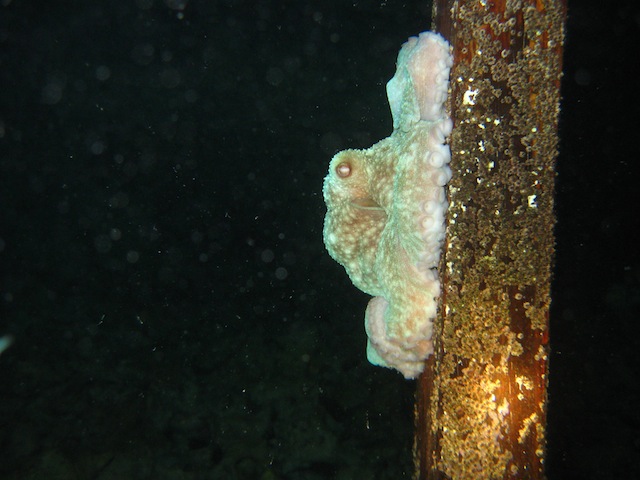
by Diane Wyse, Physical Oceanography Lab
“What was THAT?!” I expressively gestured to my snorkel buddy, Alex. A streak of bright green and pink that seemed to move too quickly for its blob-like shape darted through the beam of my dive light. As we kicked through the warm moonlit water off the Lee Stocking Island dock, we came across many cool creatures that lay hidden during the daylight hours. Driven partly by curiosity for exploration, and partly by my wild imagination for what could be lurking in the dark, I took a breath and dove down to take a closer look. With a little patience and persistence, we spotted it again, this time stationary on a dock post, posed as though it was ready for a chase. That beautiful animal that had caught my eye, much to my delight, was a spunky little octopus. It was a brief but exciting first encounter with one in the wild. To this day I am still in awe of that cryptic critter’s grace and agility.

Cephalopods (octopuses, squids, nautiluses, and cuttlefish) are predatory invertebrates found in oceans throughout the world. They are fascinating and charismatic, with cool chromatophores that they use for camouflage and communication.
As a recent transplant from the east coast, I cannot yet speak of encounters with cephalopods while diving in the cool Pacific waters, though I am keeping an eye out for them! A recent graduate, Erin Jensen, studied octopods during her time at Moss Landing, and you can find a post related to her research here.
Check out this neat post about cephalopods by invertebrate zoologist and echinoderm expert Dr. Chris Mah in recognition of Cephalopod Awareness Days.
Can’t get enough? See a Giant Pacific Octopus on exhibit at the Monterey Bay Aquarium.
Do you have photos or stories about cephalopods? Visit the MLML Facebook page and share!

